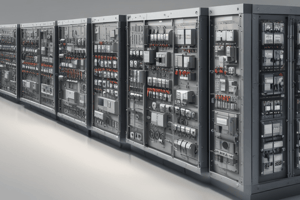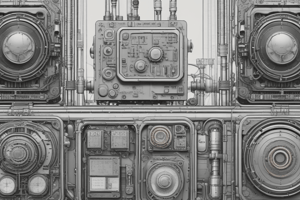Podcast
Questions and Answers
What main function does a Programmable Logic Controller (PLC) serve in automation systems?
What main function does a Programmable Logic Controller (PLC) serve in automation systems?
- It executes logic operations for process control automation. (correct)
- It provides mechanical operations through hardware components.
- It regulates data collection from sensors and actuators.
- It manages the internet connection for remote monitoring.
Which of the following protocols is commonly used to ensure data transfer in industrial communication systems?
Which of the following protocols is commonly used to ensure data transfer in industrial communication systems?
- Zigbee
- Bluetooth Low Energy
- Modbus (correct)
- Wi-Fi Direct
In the context of the Internet of Things (IoT), what role does artificial intelligence (AI) play in a mushroom farm?
In the context of the Internet of Things (IoT), what role does artificial intelligence (AI) play in a mushroom farm?
- It automates the watering schedule based on manual inputs.
- It monitors sales data for mushroom products.
- It tracks the labor costs associated with farming.
- It adjusts environmental controls automatically based on temperature changes. (correct)
What is the initial step in the end-to-end process of creating electronic devices in industrial electronics?
What is the initial step in the end-to-end process of creating electronic devices in industrial electronics?
Which aspect is emphasized in the system-level design within industrial electronics?
Which aspect is emphasized in the system-level design within industrial electronics?
In the context of industrial electronics, what is the primary function of a PUT (Programmable Unijunction Transistor)?
In the context of industrial electronics, what is the primary function of a PUT (Programmable Unijunction Transistor)?
What is the key relationship between the SCR (Silicon Controlled Rectifier) and the UJT (Unijunction Transistor) in the context of triggering circuits?
What is the key relationship between the SCR (Silicon Controlled Rectifier) and the UJT (Unijunction Transistor) in the context of triggering circuits?
How does the four-layer diode (Shockley diode) resemble an SCR?
How does the four-layer diode (Shockley diode) resemble an SCR?
What is the main difference between a relaxation oscillator and a conventional oscillator, as discussed in the provided text?
What is the main difference between a relaxation oscillator and a conventional oscillator, as discussed in the provided text?
What essential function does an SCR provide in the context of power circuits?
What essential function does an SCR provide in the context of power circuits?
Flashcards
Programmable Logic Controllers (PLCs)
Programmable Logic Controllers (PLCs)
PLCs are industrial digital computers used for automation of electromechanical processes.
Supervisory Control and Data Acquisition (SCADA)
Supervisory Control and Data Acquisition (SCADA)
SCADA is a system that monitors and controls industrial processes using data acquisition.
Sensors
Sensors
Sensors collect data from the environment, such as temperature or pressure.
Actuators
Actuators
Signup and view all the flashcards
Internet of Things (IoT)
Internet of Things (IoT)
Signup and view all the flashcards
Importance of PUTs
Importance of PUTs
Signup and view all the flashcards
SCR Triggering
SCR Triggering
Signup and view all the flashcards
Relaxation Oscillator
Relaxation Oscillator
Signup and view all the flashcards
Shockley Diode
Shockley Diode
Signup and view all the flashcards
Industrial Test Equipment
Industrial Test Equipment
Signup and view all the flashcards
Study Notes
Industrial Electronics
- A specialized branch of electronics focusing on the design, implementation, and optimization of electronic devices and systems used in industrial environments.
- Key aspects include robustness (ability to withstand harsh conditions), efficiency (high performance in large-scale operation), and integration (seamless operation through combining sensors and actuators).
Key Components: Power Electronics
- Includes devices like thyristors, MOSFETs, and IGBTs used for motor drives, power conversion, and control systems.
Key Components: Automation Systems
- Includes Programmable Logic Controllers (PLCs) and Supervisory Control and Data Acquisition (SCADA) systems for process automation.
Key Components: Sensors and Actuators
- Facilitates data collection and mechanical operations.
- Communication Systems ensure seamless data transfer between devices and control units using protocols like Modbus, Ethernet/IP, and Profibus.
Key Components: ESD Principles
- ESD encompasses the end-to-end process of creating electronic devices from conceptualization to implementation.
- Incorporating ESD principles into industrial electronics involves design for manufacturability, energy efficiency, and embedded system integration.
System-Level Design in Industrial Electronics
- The design process involves requirement analysis, system integration, and reliability testing.
- Requirement analysis involves specifying the industrial needs (e.g., motor control, process monitoring).
- System integration defines how hardware and software components are combined based on the requirements.
- Reliability testing ensures the system's durability in industrial applications (e.g., considering voltage increase or temperature variations).
Applications of Industrial Electronics in ESD
- Smart Manufacturing: Integrates advanced control systems that use IoT devices for predictive maintenance.
- Renewable Energy Systems: Power electronics plays a critical role in converting and managing renewable energy sources.
- Automation and Robotics: Industrial electronics provide necessary components like sensors, actuators, and power systems for robots.
Thyristors
- Thyristors combine the characteristics of thyratrons and transistors.
- Thyratrons are gas-filled tubes used for high-power switching.
- Thyristors are solid-state equivalents of thyratrons.
- Mostly four-layer, three-junction semiconductor devices used in power applications.
- Examples Include SCRs, DIACs, Triacs, GTOs, SCSs, LASCRs, SUSs.
The Silicon Controlled Rectifier (SCR)
- A four-layer device with three terminals (anode, cathode, and gate).
- Operates in an "off" state (blocking current) until a gate signal triggers it, allowing current flow from anode to cathode.
- Remains "on" until the current drops below the holding current.
- Commonly used for controlling high-power loads, AC-to-DC conversion, and soft starting of motors.
- Industrial Systems: Used for control of power supplied to devices like motors, heaters, and high-power loads; as rectifiers in AC-to-DC conversions, in phase-controlled rectifiers for dynamic voltage and current control, and soft starters of motors to reduce stress and current surges.
Importance of SCRs
- Motor Speed Control
- Industrial Heating
- Power Conversion
- Static Switches
- Voltage Regulation
Practical Demonstrations
- Lamp Control
- Motor Starter
- Rectifier Operation: Practical demonstrations of SCRs in various applications.
The Unijunction Transistor (UJT)
- A three-terminal device with only one PN junction.
- Used for oscillators, trigger circuits, sawtooth waveform generators, timing circuits, and bistable network.
- UJTs primarily interact in systems by triggering power devices (e.g., SCRs and TRIACs), acting as oscillators for timing and control, and enabling time delay circuits for automation applications.
Importance of UJTs
- Triggering Circuits
- Relaxation Oscillators
- Time Delay Circuits
- Waveform Generation (SCR and TRIACs)
Practical Demonstrations
- SCR Triggering
- Relaxation Oscillator
- Time Delay Functionality
The Programmable UJT (PUT)
- A programmable unijunction transistor that solves the problem of the fixed intrinsic standoff ratio in UJT.
- PUTs have multiple PN junctions and differ in structure and operation from the original unijunction transistors.
- Similar characteristics to UJT. Generally used for the same purpose.
The Programmable UJT (PUT)
- A 4-layer PNPN device.
- The gate is connected to the sandwiched n-type layer.
- Part of the Thyristor family.
- Similar device design and schematic symbol compared to the SCR.
- Gate current triggers the PUT when anode-cathode junction is forward biased.
- PUTs are three-terminal semiconductor devices with programmable threshold voltages.
The Programmable UJT (PUT) - Functioning
- External Resistors program the voltage at which the PUT conducts.
- Operates as a switch, staying off until input voltage exceeds the programmed threshold, then turns on.
- Used in relaxation oscillator circuits to produce periodic signals
How PUTs Interact Within Systems
- Triggering Thyristors: Provides precisely timed gate pulses for SCRs or TRIACs.
- Signal Control: Acts as oscillators for timing and sequencing applications.
- Voltage and Current Management: Enables smooth transitions and regulated responses in automation systems.
Importance of PUTs
- Triggering Circuits
- Oscillator Circuits
- Time Delay Circuits
- Industrial Test Equipment
Practical Demonstrations
- SCR Triggering
- Relaxation Oscillator
- Time Delay Examples
The Four-Layer Diode (Shockley Diode)
- A four-layer pnpn diode with two terminals.
- Operates similar to an SCR, without a gate terminal (IG=0).
- Remain in a high-resistance state until the breakover voltage is reached, then switches to low-resistance.
- Useful for triggering SCRs, overvoltage protection, and clamping excessive voltage.
How Shockley Diodes Interact Within Systems
- Voltage Threshold Switching: Conducts only when the applied voltage exceeds a specific breakover voltage.
- Triggering Power Devices: Provides initial trigger for SCRs/TRIACs.
- Overvoltage Protection: Serves as a protective component to clamp excessive voltage in sensitive circuits.
Importance of Shockley Diodes
- Triggering circuits
- Overvoltage protection
- Voltage sensing
- Pulse generation
Practical Demonstrations
- Threshold Switching
- Triggering SCRs
- Overvoltage Protection
Diode for AC (DIAC)
- A two-terminal thyristor that can conduct current in either direction.
- Conducts when breakover voltage is reached (regardless of polarity).
- Turns off when current drops below holding value.
- Primarily used as a trigger for other thyristors, especially TRIACs, in AC power systems.
- Key function: Provides symmetrical gate triggering for TRIACs in phase control applications.
How DIACs Interact Within Systems
- Thyristors (e.g., TRIACs): Provides symmetrical gate triggering for TRIACs.
- Sensors and Actuators: Works alongside to monitor physical parameters (e.g., sensors) and actuators (e.g., motors).
- Control Circuits: Serves as part of power feedback loops for regulation and dimming systems.
Importance of DIACs
- Triggering TRIACs
- Power Regulation
- Waveform Shaping
- Voltage Threshold Devices
Practical Demonstrations
- Phase Control for Lighting
- Motor Speed Control
- AC Waveform Triggering
Triode for AC (TRIAC)
- Essentially a DIAC with an additional gate terminal.
- Can be turned ON by a gate current pulse.
- Functions as a bidirectional switch, conducting current in either direction.
How TRIACs Interact Within Systems
- Sensors: Receive signals to adjust power output accordingly.
- Actuators: Regulate actuator operation by controlling the phase of AC voltage.
- Triggering Devices: Often triggered by DIACs to ensure smooth and symmetrical operation.
Importance of TRIACs
- Lighting Control
- Motor Speed Regulation
- Temperature Control
- AC Power Switching
Practical Demonstrations
- Light Dimming
- Motor Speed Control
- Temperature Regulation
Silicon Bilateral Switch (SBS)
- A bilateral breakover device, similar to a DIAC.
- Can conduct current in either direction.
- Turns off when current falls below holding current.
- Typically used in low-voltage trigger circuits, as a trigger source for TRIACs, and to detect voltage changes from sensors.
How SBSs Interact Within Systems
- With TRIACs: Acts as a reliable and efficient trigger source.
- With Sensors: Collaborates with sensors to detect voltage or current levels.
- With Actuators: Controls actuators indirectly.
Importance of SBS
- Triggering TRIACs in phase-control circuits
- Relaxation Oscillators
- Waveform Control
- Overvoltage Protection
Practical Demonstrations
- Triggering a TRIAC in a dimmer circuit
- Pulse Generation
- Waveform Shaping
Silicon Unilateral Switch (SUS)
- A four-layer semiconductor device.
- Unidirectional conduction; conducts current in only one direction.
- Voltage-threshold switching: Remains in high impedance state until breakover voltage is reached.
- Built-in triggering (integrated trigger diode for precise control).
- Non-latching behavior; returns to off state when current drops below holding current.
How SUS Interact Within Systems
- With Sensors: Detects changes in voltage or current.
- With Actuators: Enables actuators to perform specific actions, based on voltage or timing.
- In Power Management: Ensure precise voltage control and protection.
Importance of SUS
- Timing Circuits
- Triggering Thyristors
- Pulse Generation
- Voltage Sensing and Control
Practical Demonstrations
- Pulse Generator Circuit
- Triggering an SCR
- Timing Control
Transducers
- Devices that convert energy from one form to another.
- In industrial electronics, they convert physical quantities (temperature, pressure, light) into electrical signals.
- They act as critical intermediaries in bridging physical processes and electronic systems, thus enabling monitoring, control, and automation.
Transducer Classification
- Active: Generate electrical output directly from the input energy without an external power source (e.g., thermocouples, piezoelectric sensors).
- Passive: Require an external power source to operate (e.g., strain gauges, capacitive sensors).
- Analog: Input quantity converts to an analog signal (continuous function of time).
- Digital: Input quantity converts to an electrical pulse, forming a unique code output.
- Primary: Mechanical device converts physical quantity into a mechanical signal.
- Secondary: Mechanical signal converts into an electrical signal.
- Inverse: Electrical signal converts into non-electrical signal. (e.g., microphone, loudspeaker)
Types of Transducers Based on Principles
- Piezoelectric
- Electromagnetic
- Electromechanical
- Thermal
- Optical
- Inductive
- Resistive
- Pressure
- Mechanical
Sensors and Actuators
- Sensors: Convert physical phenomena (pressure, temperature, light) into electrical signals.
- Actuators: Convert electrical signals into physical actions (motion, force, heat). Examples include:
- Electric motors and solenoids
- Hydraulic or pneumatic actuators (cylinders, motors)
- Mechanical actuators (gears, levers)
- Magnetic actuators (voice coils, latches)
- Electro-hydraulic Actuators
- Rotational Actuators
- Linear Actuators
Temperature Sensors
- Devices that measure temperature and provide electrical output signals.
- Convert thermal energy into electrical signals by detecting changes in resistance, voltage, or current (e.g., thermocouples, Resistance Temperature Detectors – RTDs, thermistors, infrared sensors).
Pressure Sensors
- Measure the force exerted by fluids (liquid or gas) per unit area.
- Use piezoelectric, capacitive, or resistive principles to convert pressure into electrical signals.
Proximity Sensors
- Detect the presence or absence of objects without physical contact using electromagnetic, optical, or capacitive effects.
- Examples include inductive, capacitive, ultrasonic, and infrared proximity sensors.
Motion Sensors
- Detect movement or changes in position in the surrounding environment.
- Measure infrared radiation emitted by objects, changes in acceleration forces (using capacitive or piezoelectric methods).
- Examples include PIR sensors and accelerometers.
Humidity Sensors
- Measure moisture content in the air by detecting changes in electrical capacitance or resistance.
- Employ hygroscopic dielectric materials or measure resistance changes related to moisture absorption.
- Examples include capacitive, resistive, and hygrometer types.
Gas Sensors
- Detect specific gases by measuring conductivity changes or chemical reactions, using thin films that react with molecules.
Force Sensors
- Measure force applied to objects by detecting changes in resistance, voltage, or deformation.
- Examples are strain gauge sensors and piezoelectric force sensors.
Sound Sensors
- Detect sound waves (vibrations in the air) and convert them into electrical signals.
- Using diaphragms to generate voltage changes from air pressure variations or by sensing high-frequency sound waves' reflections.
Electronic Systems
- Sets of integrated hardware and software that process, monitor, control, or automate tasks using electrical signals.
- Essential in industrial, commercial, and residential settings to enhance efficiency, safety, and comfort.
Programmable Logic Controllers (PLCs)
- Industrial computers that automate machinery, processes, or manufacturing lines.
- Monitor input signals (e.g., sensors) and execute programmed logic to control output signals (e.g., actuators).
Building Management Systems (BMS)
- Centralized systems that monitor and control building operations, including HVAC (heating, ventilation, and air conditioning), lighting, and energy management. Optimize energy consumption and maintain occupant comfort.
Security and Surveillance Control Systems
- Systems for monitoring, detecting, and responding to security breaches.
- Use cameras, alarms, and access control devices for real-time surveillance, automated alerts, and preventing theft/vandalism.
Audio-Video and Lighting Controls
- Systems manage audiovisual presentations and lighting to enhance ambiance.
- Enable remote or automated control of lighting and AV equipment, often integrated with smart home technology.
Supervisory Control and Data Acquisition (SCADA)
- Systems monitor and control industrial processes by collecting real-time data to enable remote operations.
- Centralized monitoring of processes like water treatment, energy distribution, and manufacturing.
Fire and Life Safety Controls
- Systems detect and respond to fire and other life-threatening situations.
- Use smoke detectors, alarms, and sprinklers to initiate emergency responses.
References
- Provide citation details using standard referencing format for listed books, etc.
Studying That Suits You
Use AI to generate personalized quizzes and flashcards to suit your learning preferences.





